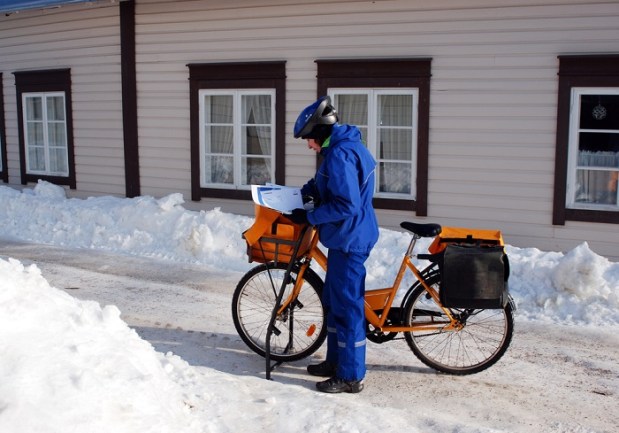The Ethics Of On-Demand Deliveries During Blizzards

After millions of Americans bemoaned their bad luck at having 70 degree temperatures on Christmas Day, many of those same people have given into the collective hysteria of shopping for supplies that accompanies every above-average blizzard to sweep up the East Coast. Although stockpiling bread, milk and a generous heaping of toilet paper got shoppers through nor’easters twice as large as Winter Storm Jonas, the new normal of ordering meals and more on demand when supplies are low poses a dilemma for the modern consumer.
After all, is it OK to make an on-demand worker brave emergency weather conditions just because the shopper doesn’t want to?
Any advancing technology will intersect with social concerns at some point, and cities are starting to grapple with the issue of consumers’ all-encompassing demand for convenience in the face of unsafe working conditions for on-demand couriers. When Winter Storm Juno dumped two feet plus of snow on New York City and Boston in Jan. 2015, NYC Mayor Bill de Blasio instituted a travel ban on all vehicles in the city, including any car, bike or pogo stick some unfortunate Chinese food runner used to get around in the snow.
“A delivery bike is not an emergency vehicle,” de Blasio said in a statement at the time, as quoted by The Guardian. “No. If you are part of the city government, if you are a first responder, if you are an essential public servant, those are the kind of people allowed on the streets. Nothing that has to do with leisure, or convenience or takeout food … We’re not doing that.”
As Washington, D.C. prepares for the worst of 2016’s first big snowstorm, no such travel ban has been instituted yet and fortunately so for most pre-blizzard on-demand shoppers. When last year’s first blizzard rolled in, alcohol delivery company Drizly saw its orders skyrocket by almost 500 percent one day ahead of the storm’s landing, according to Eater.
That’s all well and good before the first flakes start to fall, but as more and more customers transition the bulk of their purchasing over to home delivery instead of doing it themselves in stores, the dilemma of who actually facilitates those deliveries becomes more and more unavoidable. And while the sample size for this kind of scenario is still fairly small, there’s already evidence that the problematic classification of many on-demand couriers as third-party contractors instead of employees means that they’re often left in a gray area of legal protections — as food delivery service GrubHub’s response to 2015’s Winter Storm Juno proved.
“We advise our restaurant partners in the Northeast to adhere to all local safety guidelines and exercise extreme caution when delivering orders,” A GrubHub spokesperson said in a statement quoted by The Guardian. “We also want to remind diners to be appreciative of, and patient with, their delivery drivers. These food heroes are braving heavy snow, wind and frigid temperatures to ensure diners can still enjoy their local favorites from the comfort of their warm homes. With this in mind, we hope diners will be patient if their orders take longer than normal to arrive and generous and appreciative when tipping their drivers.”
Passing the buck for protections surrounding on-demand employees might not give GrubHub any goodwill with its customers and clients, but it’s at least an honest sign of the evolving times at the edges of the retail industry. Winter Storm Jonas isn’t likely to be the only major blizzard of the winter, though, so on-demand delivery services, like GrubHub, Seamless and (in some cities) even Amazon, will have to confront the issue of promising their customers 24/7 access to their favorite items, while making sure that the people actually slogging through the snow aren’t being left out in the cold.
